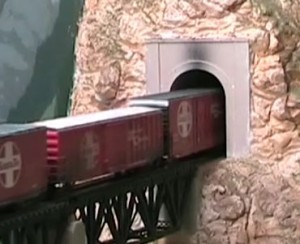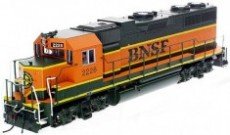Everything on model trains, model railroads, model railways, locomotives, model train layouts, scenery, wiring, DCC and more. Enjoy the world's best hobby... model railroading!
Special Train Ride
Bob sent in these train memories to share:
“During the summer between my freshman and sophomore years in high school I was selected to attend a camp in NC by a national organization which shall remain nameless. I traveled by train from Tampa to NC with a layover in Jacksonville to pick up the Pullmans and to meet up with other campers from other parts of Florida. The berths were prepared and off to to bed we went. We pulled into Savanah and I asked the girl below me if she knew where we were, what was going on, and she invited me to join her so I could see for myself. I know she had no idea what she had done. After some minutes we pulled out of the station and one thing led to another. There is much to be said about the romance of the rails, even though it can’t be said here. But I’m 72 years old and haven’t forgotten it yet.”
O27 and O Scale Train Database
Ken has a question for readers:
“I was wondering if anyone has ever put together a database for Lionel trains that basically lists all the various engines, cars, various data (yr built, gauge) etc. and allows a user to customize their own usage by putting in additional fields, serial numbers, pictures, etc to develop a ownership database.”
Another reader has a quick question about decals:
“Where do the PRO’S get their road name and data decals ?”
Add your answers or suggestions below.
What Are Your Best Railroading Memories?
 We all like to get a little nostalgic from time to time, so why not right now?
We all like to get a little nostalgic from time to time, so why not right now?
Send in your best railroading memories and over the next few days we’ll publish the best one’s on the blog for everyone to read.
Complete the form at http://www.model-railroad-resources.com/memories.html to submit your railroading memories for publication on the blog.
Building a Mountain for Your Layout
 There are various ways to construct scenery. This method for making mountains has been sent in by Harold who has been following this blog since 2005, and who has been involved in the hobby for 35 years:
There are various ways to construct scenery. This method for making mountains has been sent in by Harold who has been following this blog since 2005, and who has been involved in the hobby for 35 years:
Model railroads are deemed incomplete without background scenery. Build landscapes at home to reduce costs. A simple mountain with a tunnel can be built by following the steps below.
- Decide the location of the mountain and take measurements of the area.
- Take newspaper strips and dip them in water.
- Immerse the strips in plaster.
- Bend chicken wire into the shape of a tunnel.
- Wrap up the wire in plastic.
- Cover the wire with the plastered strips.
- Use molding plaster around the wire and shape the entire structure into a mountain.
- Paint the mountain when the model is completely dry.
Add your comment below.
More MODEL TRAIN TIPS
Poll Results: Do You Repair Your Own Model Train Stuff?
384 model railroaders responded to our last poll which asked:
Do You Repair Your Own Model Train Stuff?
Results were as follows:
– In addition to doing ALL minor repairs including dismantling and cleaning motors etc. I ALSO install and replace decoders, program decoder functions (29%)
– As well as ALL minor repairs I dismantle and clean motors, replace motors, and clean gears (22%)
– I do minor repairs, AS WELL AS some repairs such as removing train body, replacing bulbs, resoldering loose wires (22%)
– I do some minor repairs eg. tightening screws, clean wheels, touch up paint, traction tires, replace couplers, sliders or pantos (15%)
– I don’t do my own repairs (8%)
– I also do repairs for others (4%)
Lionel Commodore Vanderbilt Train Set Transformer
Bob asks readers for advice:
“I have a very old and running Lionel Commodore Vanderbilt train set – locomotive, coal car, fuel car and caboose. I need to replace the transformer – what do you recommend?”
Comment below.
OO Gauge Power Type
Bobby want to hear reader’s opinions and asks:
“I am in the U.S., and have acquired a OO gauge Hornby London 2012 train pack R2961 (no track or transformer). The loco is designed to run on variable 12V DC power supply. I have a Bachmann HO transformer #46605A. Will that operate this train without harm?”
Add your comment below.
Block Signals
Joe asks readers for advice:
“I need a wiring diagram showing the connections for 3 LGB semaphores automatically stopping and starting trains in a simple loop; non-dcc; train power from the track via a transformer. Can someone please help.”
Answer below.
A Versatile Clay For Model Railroad Scenery
 I don’t generally promote particular brands or products, but this is product I have used with success. Das is a cold-cure modelling clay ideal for constructing the base for groundwork e.g. indoor floors, areas of outside land etc. It is also useful for constructing buildings and structures. No baking is needed (it air dries), it is easy to smooth, and can be painted (it comes in white or a terracotta color). White is probably best if you are going to paint it in light color shades.
I don’t generally promote particular brands or products, but this is product I have used with success. Das is a cold-cure modelling clay ideal for constructing the base for groundwork e.g. indoor floors, areas of outside land etc. It is also useful for constructing buildings and structures. No baking is needed (it air dries), it is easy to smooth, and can be painted (it comes in white or a terracotta color). White is probably best if you are going to paint it in light color shades.
I would be interesting to hear what other products people use, and what uses they have for Das or other clay products. As I said at the beginning, I am not here to push any one brand over another, so if you can suggest something better I would be interested in your comments.
Add your comment below.
DCC Compatible Vs Electrically Controlled Model Railroads
Sam sent in these thoughts:
“Many people erroneously believe that electrically controlled model railroad networks can’t provide speed control, backward and forward movement and many other sophisticated controls that DCC compatible model railroads have but this assumption is very wrong. If it is so, why are some of the best laid layouts these days controlled with DCC? The answer is simple; setting up electrical layouts with complex setups and sophisticated operational setups is a task that consumes several hours and massive technical skills. DCC on the other hand is easy and can be setup effortlessly although it is a little expensive.”
Tips For Soldering Track
The techniques used for achieving good looking and reliable solder joints are not difficult to master. Yes, it will require some practice, but anyone can do it.
There key points for creating high quality solder joints on track are:
1. Keep your works surfaces and tools clean.
2. Use acid based solder paste flux.
3. Purchase a good quality soldering iron (with a replaceable tip). A small diameter solder – a .020 inch or smaller works best.
5. For soldering track a 35W to 45W pencil type iron works well.
POLL RESULTS: What Type Of Railroad Do You Operate?
Our recent poll asked model railroaders: What type of railroad do you prefer to model, a prototypical railroad that exists (has existed), or a fictional railroad that you (or someone else) has created?
Hundreds responded and the results were as follows:
– Fictional (71%)
– Prototypical (29%)
The Factors that Determine the Operational Capacity of a Railroad

Smooth operation is critical for the efficiency and profitability of real railroads. Applying these techniques can also make the hobby of model railroading even more enjoyable.
Article supplied courtesy of the online Model Train Club.
Whether you are operating your model railroad just casually for fun, or whether you are trying to replicate actual operations of a real railroad, there are various factors to consider. After all, there is no point in just having trains backed-up with nowhere to go. A real railroad would come to a standstill (and soon go broke) without properly managed train operations. Even on a model railroad, complete disorder and confusion and quickly develop without properly organized train movements. Factors to take into account include:
Line Capacity:
- – the number of tracks available
- – the geography, gradients (mountains), number of bridges, tunnels etc.
- – the mix of trains (passenger, freight etc) – schedules, type of service
- – the number and the horsepower of loco’s – train length and weight
- – the type and the spacing of the control system
- – the number, the spacing, and the length of sidings
- – the operating and maintenance plans – type of signals, spacing etc.
Yard Capacity:
- – the space available – total acreage (or square footage on a model layout)
- – the number of tracks
- – container storage slots
Equipment Capacity:
- – locomotives
- – cars
- – containers/trailers
Crew Capacity:
- – yard crews
- – maintenance crews
- – crew rosters
Although most railroads would like to operate at 100% capacity (to maximize profits), it is not usually feasible or economic to do so. A target of 70% to 80% is usually more realistic. In fact; industry practices generally require standards to ensure fluidity of operations and to avoid major operational issues at track choke-points.
Various factors can influence efficiency and the practicality of running a line at full capacity including:
- – Maintenance – railway lines need maintenance from time to time which can delay schedules
- – Traffic volumes will vary throughout the day
- – Weather can cause disruptions, damage, as well as cause unexpected and compounding delays across a railroad
To try and increase the operational capacity above an effective level can be problematic. It could be achieved by deferring maintenance, but this could affect future capacity if there is a signal breakdown or derailment that could have been prevented with regular maintenance. It could reduce the railroad’s ability to react to a situation and/or increase the recovery time following a delay or stoppage. This could affect reliability, customer satisfaction, and potentially impact the profitability and reputation of the railroad.
Efficient train operation therefore needs to (among other things) :
- – Identify timetable/schedule conflicts or potential delays
- – Manage time-distance and time-space between trains
- – Manage train priorities, schedules, train size and type, power, direction, connections, drop-offs and pick-ups
- – Identify potential slots where new services could be added
- – Strategically plan and schedule track and signal maintenance (apply/remove speed restrictions)
- – Manage resources – personal (crews), and trains (trip times, locomotive miles etc)
These are the kinds of day to day challenges facing a normal real-sized railroad, so why not apply similar conditions to your model railroad layout? Replicating real life conditions can add considerable operational interest to a layout and make the hobby so much more enjoyable!
Article supplied courtesy of the online Model Train Club.
Dull Colors For Distance
 The further away you stand from an object in the real life, the duller (or grayer) and less clear it appears. The viewing distance for models doesn’t usually vary much with their scale, so the smaller the scale, the duller the colors need to be. You can achieve this scale effect by mixing colors (full-strength) with varying amounts of light gray, white, or gray-blue.
The further away you stand from an object in the real life, the duller (or grayer) and less clear it appears. The viewing distance for models doesn’t usually vary much with their scale, so the smaller the scale, the duller the colors need to be. You can achieve this scale effect by mixing colors (full-strength) with varying amounts of light gray, white, or gray-blue.
Keep a note of any special paint mixes you make up. This is really helpful if you think you might need the exact same color again. You can do this by spraying or painting the color onto a scrap of white card and recording the details alongside.
There are more scenery ideas in the members area of the online Model Train Club.















